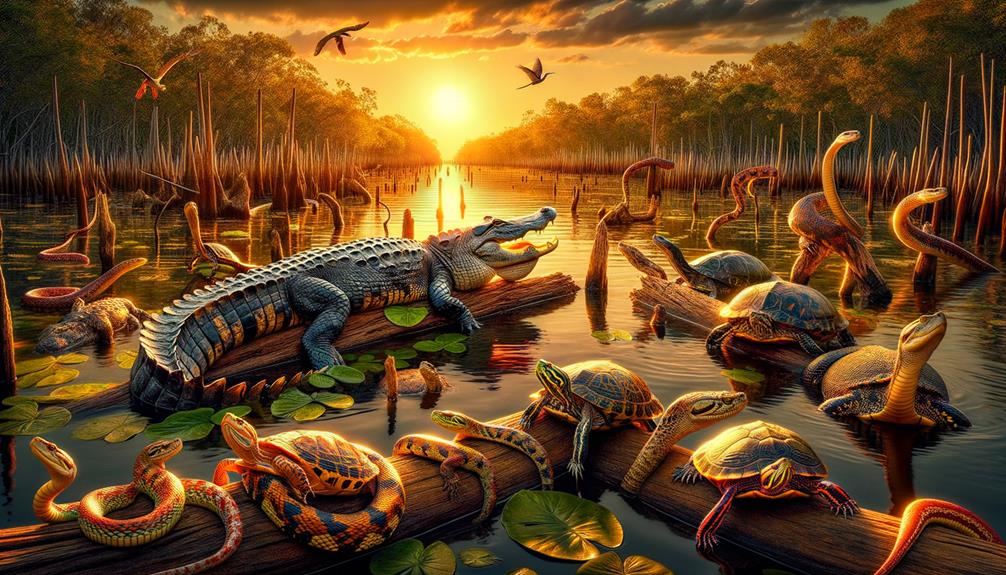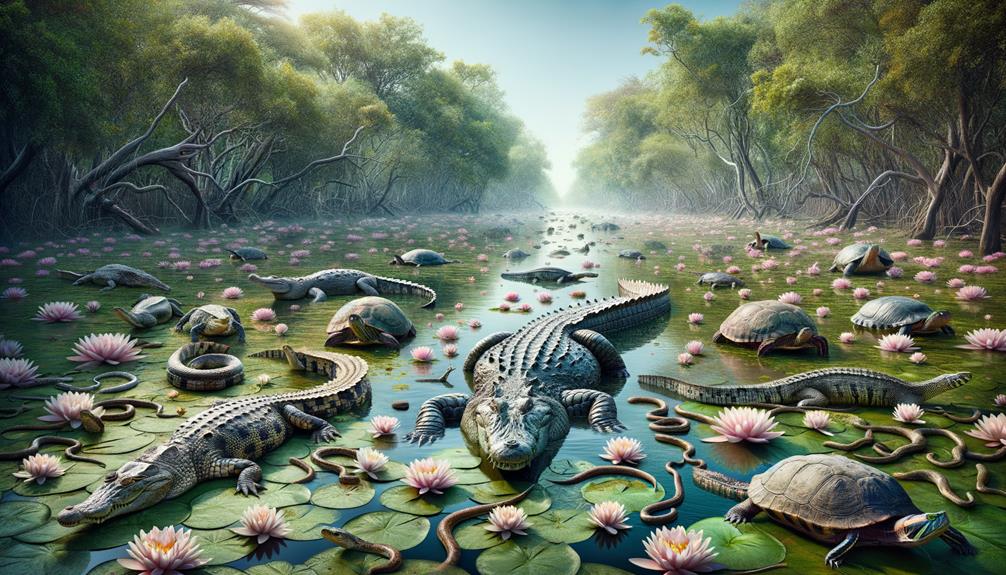I've had the privilege of studying the aquatic herpetofauna of the Mekong Delta in great depth. The region's varied wetland ecosystems, including flooded grasslands, swamp forests, and canals, provide a habitat for unique species like the Mekong Delta Water Snake (Enhydris innominata), characterized by its distinct black blotches and prominent scale counts. The seasonal water level changes have a significant impact on species distribution, making conservation efforts a high priority. The herpetofauna in this region play a vital role in maintaining ecosystem health, contributing to nutrient redistribution and insect control. However, they face significant threats from habitat loss, pollution, and climate change. There's still much to learn about these complex dynamics.
Key Takeaways
Mekong Delta Water Snake, Enhydris innominata, is found only in the Mekong Delta and flourishes in flooded grasslands, swamp forests, and canal networks.
The water level changes in the Mekong Delta throughout the year affect where species live and how vulnerable they are.
Snakes and frogs play vital roles in maintaining the balance of the ecosystem.
The destruction of habitats due to urbanization, farming, and infrastructure development poses a significant threat to the biodiversity of the Mekong Delta.
To conserve the region's biodiversity, efforts are being made to restore habitats, enforce anti-poaching laws, breed species in captivity, and collaborate with neighboring countries.
Key Species Overview
In the Mekong Delta's aquatic herpetofauna, the Mekong Delta Water Snake (Enhydris innominata) stands out due to its unique distribution and distinct physical characteristics. Found only in the Mekong Delta region of Vietnam and Cambodia, this species greatly contributes to the biodiversity of aquatic organisms in the area. The snake's gray-brown to dark brown coloration, accented with black blotches, makes it easily identifiable.
Reaching up to 70 cm in length, the snake features a specific scale count, including 21 midbody scales, 106-117 ventral scales, and 42-56 subcaudal scales. These physical traits, particularly the scale counts and color patterns, set it apart from similar species like the Jagors Water Snake and Long-tailed Water Snake. Accurate identification of this snake highlights the significance of detailed taxonomic studies in understanding the region's biodiversity.
The Mekong Delta Water Snake's restricted distribution also challenges previous assumptions of a wider Southeast Asian range, emphasizing its unique role within the Mekong Delta's ecosystem. This specificity underscores the need to protect and study the delicate balance of the region's aquatic habitats to preserve its diverse herpetofauna.
Habitat and Distribution
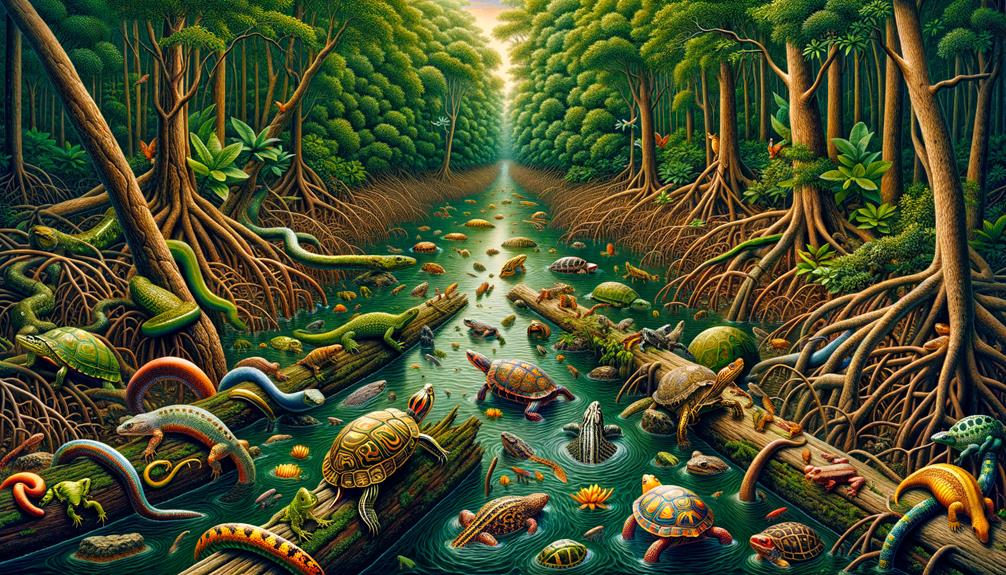
When examining the habitat and distribution of the Mekong Delta's aquatic herpetofauna, I look at the diverse wetland ecosystems that support these species. The changing water levels throughout the year significantly impact their breeding and foraging patterns. The geographic range of species like the Mekong Delta mud snake highlights their remarkable adaptability to this dynamic environment.
Diverse Wetland Ecosystems
The Mekong Delta's diverse wetland ecosystems, featuring flooded grasslands, swamp forests, and intricate canal networks, are crucial for sustaining a rich array of aquatic herpetofauna. These varied habitats create unique microenvironments where water and water flow dynamics are vital. The flooded grasslands, with seasonal inundation, support species adapted to fluctuating water levels. Swamp forests, characterized by dense vegetation and standing water, provide shelter and breeding grounds for numerous aquatic reptiles and amphibians.
The canal networks, essential for water flow and distribution, interconnect these ecosystems, allowing the movement and migration of species. This hydrological connectivity is necessary to ensure the dispersal of nutrients and organisms, maintaining the ecological balance. The Mekong Delta Water Snake, endemic to this region, thrives in these wetland ecosystems, exemplifying the intricate relationship between habitat and species.
| Ecosystem Type | Key Features | Representative Species |
|---|---|---|
| Flooded Grasslands | Seasonal water levels | Mekong giant catfish |
| Swamp Forests | Dense vegetation, standing water | Irrawaddy dolphin |
| Canal Networks | Hydrological connectivity | Mekong Delta Water Snake |
| Wetland Ecosystems | Nutrient dispersal | Various snake and fish species |
Understanding these ecosystems is vital for conservation efforts, which are necessary to ensure the survival of the region's unique herpetofauna.
Seasonal Water Level Changes
Seasonal water level fluctuations in the Mekong Delta have a profound impact on the habitat and distribution of its aquatic herpetofauna. During the monsoon season, the Delta experiences high water levels, flooding vast areas and creating a dynamic environment. This allows aquatic species like snakes and frogs to expand their ranges, taking advantage of the abundance of resources. They find suitable breeding sites, rich feeding grounds, and sufficient shelter, enabling populations to thrive.
In contrast, the dry season brings low water levels, confining the aquatic herpetofauna to permanent water bodies. This concentration increases their vulnerability to predation, human activities, and other threats. Understanding their behavior and habitat requirements becomes crucial during these times for effective conservation strategies.
The Mekong Delta's ecosystem is intricately linked to seasonal water level changes, which dictate the movement and survival of its aquatic species. By studying these fluctuations, we can better understand the ecological needs and challenges faced by the herpetofauna, ultimately ensuring their preservation. This knowledge is vital for maintaining the delicate balance of life within the Mekong Delta and safeguarding its vibrant biodiversity for future generations.
Species Geographic Range
In the Mekong Delta, the geographic range of species is shaped by unique habitats and distribution patterns that define the region's aquatic herpetofauna. The Mekong Delta water snake (Enhydris innominata) is a prime example, found only in Vietnam and Cambodia's Mekong Delta region. This species thrives in flooded grasslands, swamp forests, and canals, showcasing its remarkable adaptation to the delta's aquatic environments and wetland habitats.
The snake's distribution is remarkably restricted, not found outside this specific region, not even in neighboring Thailand. This limited range highlights the critical importance of the Mekong Delta as the snake's entire global habitat. As a result, the Mekong Delta water snake is a threatened species, with its survival closely tied to the health and preservation of its native habitats.
Understanding the geographic range of the Mekong Delta water snake underscores the delicate balance within these ecosystems. Preserving these habitats is crucial not only for the snake's survival but also for maintaining the region's biodiversity. The Mekong Delta's wetland habitats are essential for supporting a wide range of species, and their protection is vital for the region's ecological health.
Conservation Status
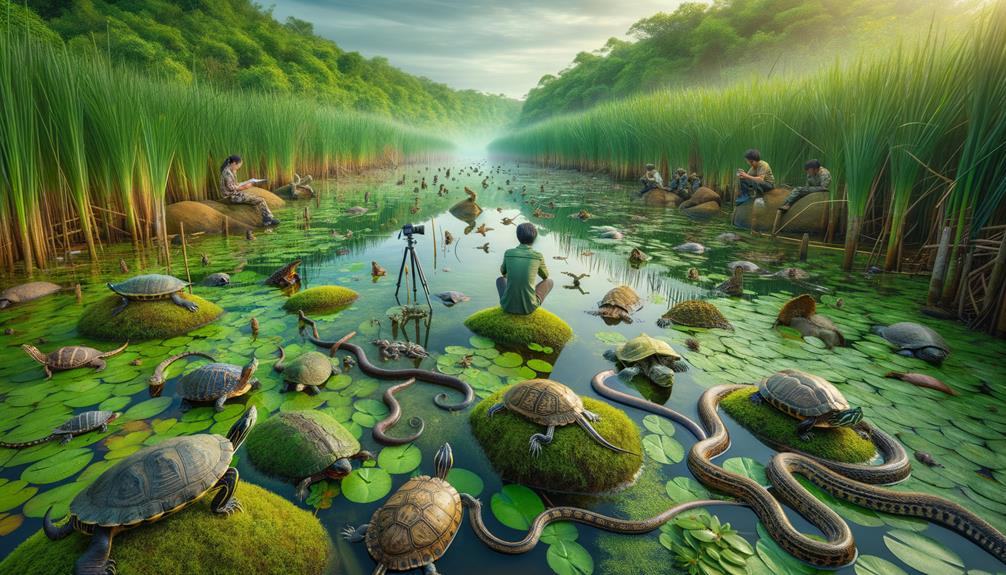
When examining the conservation status of the Mekong Delta's aquatic herpetofauna, it's clear that habitat loss and degradation pose significant threats to species like the critically endangered Siamese crocodile and the endemic Mekong Delta Water Snake. The Irrawaddy dolphin's endangered status highlights the impact of human activities, including unsustainable fishing practices and habitat disruption. What's more, many species remain unknown, which underscores the pressing need for thorough scientific research and targeted conservation strategies.
Threatened Species List
The Mekong Delta's aquatic herpetofauna is facing a dire situation, with several species teetering on the brink of extinction. The biodiversity of the Mekong is under severe threat, and it's critical we take action now.
Consider the numbers: the Irrawaddy dolphin, for instance, is critically endangered, with only around 80 individuals remaining in the Mekong River. The Siamese crocodile is also critically endangered, with fewer than 100 individuals left in Cambodia and Vietnam. The Mekong Giant Catfish has experienced a staggering 90% population decline over the past decade.
The Sarus crane, the world's tallest flying bird, is also at risk, with only around 1,000 individuals remaining in Vietnam and Cambodia. Other endangered species in the Mekong Delta region include the smooth-coated otter, wild water buffalo, and Helen's flying frog. These alarming figures highlight the urgent need for conservation efforts.
It's crucial we address the threats facing these species and work towards a future where the Mekong's aquatic herpetofauna can thrive once more.
Habitat Loss Impacts
The Mekong Delta, a globally significant wetland in Vietnam, faces severe habitat loss and degradation due to urban expansion, agricultural development, and hydropower construction. This has resulted in widespread habitat destruction and fragmentation, posing a significant threat to the region's unique herpetofauna.
Species like the Siamese crocodile and Annam leaf turtle are critically endangered, primarily due to the conversion of wetlands into agricultural and aquaculture areas. Wetland drainage disrupts their natural habitats, leading to substantial population declines. The introduction of invasive species and pollution from industrial and agricultural runoff further exacerbate their plight.
To mitigate these impacts, conservation efforts are crucial. Habitat restoration projects, anti-poaching measures, and community-based management strategies are vital in protecting the Mekong Delta's unique herpetofaunal diversity. By addressing habitat loss and implementing robust conservation strategies, we can work towards preserving these invaluable species and their essential wetland ecosystems. It is vital that we coexist sustainably with nature to ensure a secure future.
Ecological Roles
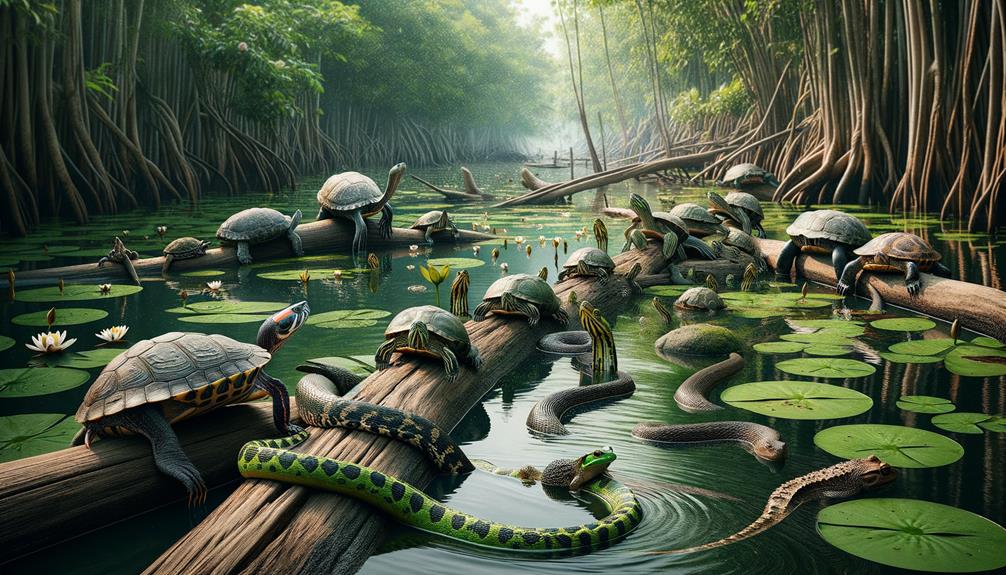
In the Mekong Delta, aquatic herpetofauna play a vital role in maintaining the health and balance of their ecosystems. These creatures, including amphibians and reptiles, are integral to the delicate web of life in the lower Mekong Basin.
Herpetofauna interact with freshwater fish, influencing their populations and behaviors. For example, amphibians serve as both predators and prey, creating a dynamic balance that helps regulate fish communities. They also contribute to water quality by consuming algae and detritus, which keeps aquatic habitats clean and hospitable for other species. These ecological functions ensure the overall resilience and productivity of the delta's ecosystems.
Herpetofauna aid in nutrient redistribution within aquatic systems by feeding on a variety of organisms. They also help manage insect populations, reducing the spread of disease. Additionally, their burrowing and nesting behaviors create microhabitats for other organisms.
Threats and Challenges

Aquatic herpetofauna in the Mekong Delta face a multitude of threats that put their survival and the health of their habitats at risk. Human activities, such as land use changes, pollution, and overexploitation, are major concerns. The rapidly growing population in the region accelerates these issues, leading to increased agricultural activities and urban development that encroach on natural habitats.
Climate change is another significant factor, causing hydrological alterations like changes in flooding patterns and salinity intrusion. These shifts disrupt the delicate balance of aquatic ecosystems, making it challenging for reptiles and amphibians to thrive. Hydrological data reveal significant fluctuations in water availability and quality, which are critical for the survival of these species.
Invasive species, such as the red-eared slider and African clawed frog, introduce competition for resources, often outcompeting native species. Unsustainable fishing practices, including the use of destructive gears and overharvesting, decimate populations of aquatic turtles and snakes. Furthermore, infrastructure development, such as dam construction and river channelization, fragments habitats and disrupts the migratory patterns essential for the life cycles of aquatic herpetofauna. These multifaceted threats require immediate attention to safeguard these important species and their ecosystems.
Conservation Efforts
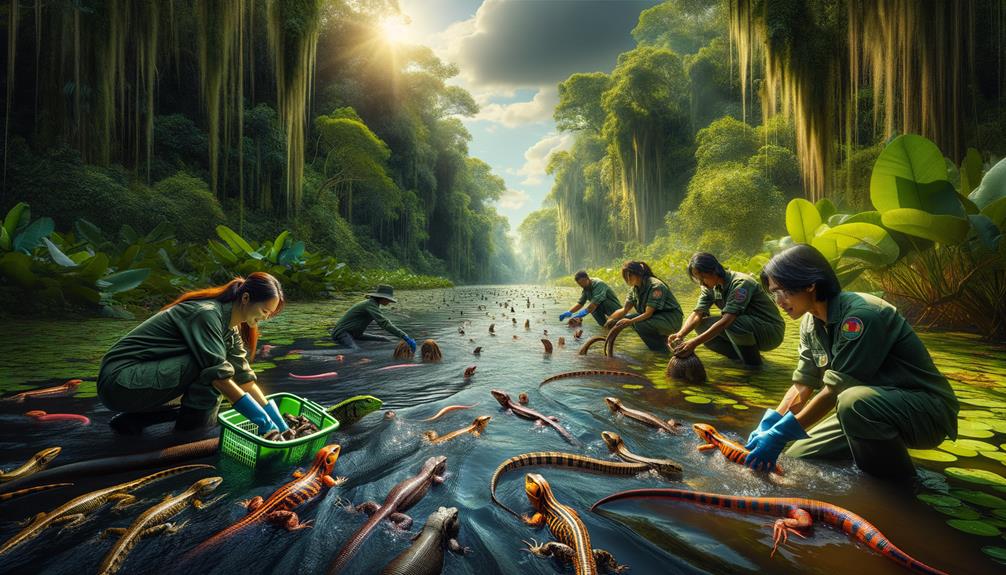
Conservation Efforts
Efforts to conserve the Mekong Delta's aquatic herpetofauna focus on protecting endangered species like the Siamese crocodile and Mekong snail-eating turtle through habitat restoration and anti-poaching measures. These efforts are crucial for maintaining the delicate balance of organisms within this biodiverse region.
To achieve these conservation goals, several strategies have been implemented:
Habitat restoration initiatives in areas like Tram Chim National Park, designated under the Ramsar Convention, aim to restore wetlands and other critical habitats. Effective enforcement of anti-poaching laws helps protect vulnerable species from illegal hunting and trade. Captive breeding programs for species like the Siamese crocodile and Vietnamese mossy frog ensure that populations can be reintroduced into the wild.
Community-based conservation initiatives are also vital. By engaging local stakeholders, we ensure that those who live alongside these organisms are actively involved in their protection. This grassroots approach fosters a sense of ownership and responsibility toward conservation efforts.
Transboundary cooperation between Vietnam, Cambodia, and Laos is necessary. As these countries share the Mekong River basin, collaborative efforts are required for the survival of these species. Through these multifaceted strategies, we strive to secure a future for the Mekong Delta's aquatic herpetofauna.
Frequently Asked Questions
Does the Mekong River Have Crocodiles?
The Mekong River is home to the critically endangered Siamese crocodile, although their numbers are alarmingly low due to habitat destruction and poaching. Their survival is precarious.
Are There Snakes in the Mekong River?
Yes, there are snakes in the Mekong River. The Mekong Delta Water Snake, in particular, calls this habitat home. Its unique scale patterns set it apart, and it thrives in the flooded grasslands, swamp forests, and canal systems.
Are There Tigers in the Mekong Delta?
There's no smoke and mirrors in the Mekong Delta – sadly, there are no tigers either. Deforestation and poaching have led to their local extinction. The region's rich biodiversity no longer includes these majestic big cats.
What Is the Mekong Delta Famous For?
The Mekong Delta is famous for its vast network of rivers, diverse aquatic ecosystems, and significant agricultural production. This region is also home to rare species like the Mekong giant catfish. However, environmental threats are now putting its ecological balance and economic contributions at risk.


